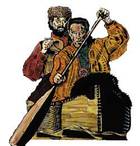Henry Kelsey - "the Boy Kelsey"

Henry Kelsey was the first white man to see the Canadian prairies. In 1692, Kelsey received little in the way of public recognition when he completed an epic, groundbreaking inland journey to the Saskatchewan River and Assiniboine country.
As a young man, Kelsey's remarkable ability to travel peacefully and respectfully among First Nations peoples, his facility for learning their languages, customs and survival skills, his tenacity, fearlessness and adventurous spirit failed to impress his Hudson's Bay Company employers. Kelsey's early expedition reports remained a Company secret and his journals were left to gather dust. It was only in his later years, as a more sedate HBC administrator and ultimately, a Governor of the famous fur trading empire, that Kelsey earned professional respect and generous financial compensation. And it was not until the 20th century, and the discovery of Kelsey's own journals, that the true accomplishments of this shadowy historical figure were revealed.
Churchill Challenge
In 1690, at the age of 23, Kelsey was already the veteran of a difficult, disappointing fact-finding journey to the Churchill River. In the previous year, with a small party of men, Kelsey had traveled north from York Factory to the river's mouth to build a trading post. Along with Captain James Young, he tried but failed to navigate a small craft through the ice on Hudson Bay. Determined to make some kind of headway in finding northern aboriginal trading partners, Kelsey set off on foot along the Bay's northern shore, accompanied by a young and inexperienced native guide. The duo struggled almost 200 kilometres through the hilly, rocky landscape, sighting musk-ox, but finding only remnants of human habitation. Wretched and discouraged, the pair trudged back to their Churchill camp.
West to Winnipeg
In 1690, Kelsey set out from York Factory once again, equipped with samples of trade goods designed to entice First Nations traders to bring their furs to Hudson's Bay. He was also under company orders to look for mines, minerals and native pharmaceuticals. This time, Kelsey headed southwest from York, but the exact nature of his route is not known. His account of the trip, discovered among private archives in 1926 (and published in 1929 as part of The Kelsey papers) indicates that he probably canoed up the Hayes River and ultimately made his way to distant "Dering Point" on the Saskatchewan River, near present-day The Pas. Whether the explorer reached his destination from the north, from Moose Lake into Cedar Lake, or from the northeast, traversing the northern end of Lake Winnipeg, remains unclear. Historical record has suggested, but not confirmed, that Kelsey was the first European to discover Manitoba's inland sea, Lake Winnipeg.
From his base at Dering Point, Kelsey explored south and west, abandoning his canoe to travel on foot through open prairie country, sighting wild pigeon, moose, grizzly bears and finally, vast herds of buffalo. Throughout his journeys, Kelsey benefited from the friendship and practical assistance of the First Nations. Ever respectful of the land's aboriginal inhabitants, and eager to learn their languages and customs, Kelsey was viewed more as an ally than a trespasser. When he returned to York Factory in 1692, he was accompanied by a fleet of aboriginal canoes. (Historical records of later years suggest that Kelsey took the time to compile a dictionary of native languages, and to teach his linguistic skills to HBC employees.)
As spectacular and significant as it appears today, Kelsey's prairie trade mission was actually an exception to 17th and early 18th century Hudson's Bay Company policy. Until rival fur traders began to threaten its monopoly, the HBC showed little interest in finding out what lay beyond its York bayside posts. Kelsey's discoveries in the interior were of only passing interest to Company officers, who failed to publish his findings or apply his new-found information to contemporary maps; some even discredited his exploits, charging that he had acted independently and without Company sanction. Apparently untroubled by his underwhelming reception, Kelsey accepted a mere £30 "gratuity" in return for 2 years of exploration, and settled into life as an HBC administrator, rising through its ranks to become the company's Governor in 1718.
Author: Fredrick Buetefuer
